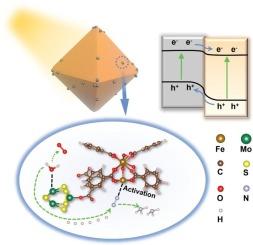MoS2 nanoparticles/MIL-100(Fe) heterojunction with Type II interfacial charge transfer for efficient photocatalytic nitrogen reduction
IF 6.5
1区 化学
Q2 CHEMISTRY, PHYSICAL
引用次数: 0
Abstract
The attainment of rapid charge mobility and effective N2 activation is of critical importance for photocatalytic nitrogen fixation but it has always been a challenge. Such challenge may be met by the construction of a Type II MoS2 nanoparticles/ MIL-100(Fe) heterojunction photocatalyst. The new material possesses charge migration channels that facilitate the separation of photogenerated carriers. This charge redistribution during photocatalysis is confirmed by experimental results showing a decrease of charge density on the Fe species and an increase of that on Mo. Moreover, DFT calculations show that the adsorption of N2 and H2O is more likely to occur on Fe sites and Mo sites, respectively. These findings clearly suggest a drastically improved spatial isolation of reduction and oxidation sites on the photocatalyst as compared to pristine MIL-100(Fe). The optimized MoS2/MIL-100(Fe) exhibits a NH4+ yield rate of 1.29 μmol·h−1 as excellent utilization of photoinduced electron-hole pairs and effective adsorption and activation of N2 become possible. This work offers an insight on the synergy of heterojunction engineering with coordinated activation for photocatalytic ammonia synthesis.


具有II型界面电荷转移的MoS2纳米颗粒/MIL-100(Fe)异质结用于高效光催化氮还原
实现快速的电荷迁移和有效的N2活化对光催化固氮至关重要,但这一直是一个挑战。这种挑战可以通过构建II型二硫化钼纳米颗粒/ MIL-100(Fe)异质结光催化剂来解决。新材料具有电荷迁移通道,有利于光生载流子的分离。实验结果证实了光催化过程中的电荷重分布,Fe的电荷密度降低,Mo的电荷密度增加。此外,DFT计算表明,N2和H2O的吸附更可能分别发生在Fe位点和Mo位点上。这些发现清楚地表明,与原始MIL-100(Fe)相比,光催化剂上的还原和氧化位点的空间隔离性大大提高。优化后的MoS2/MIL-100(Fe)的NH4+产率为1.29 μmol·h−1,充分利用了光致电子-空穴对,实现了对N2的有效吸附和活化。这项工作提供了对异质结工程与协调活化光催化合成氨的协同作用的见解。
本文章由计算机程序翻译,如有差异,请以英文原文为准。
求助全文
约1分钟内获得全文
求助全文
来源期刊

Journal of Catalysis
工程技术-工程:化工
CiteScore
12.30
自引率
5.50%
发文量
447
审稿时长
31 days
期刊介绍:
The Journal of Catalysis publishes scholarly articles on both heterogeneous and homogeneous catalysis, covering a wide range of chemical transformations. These include various types of catalysis, such as those mediated by photons, plasmons, and electrons. The focus of the studies is to understand the relationship between catalytic function and the underlying chemical properties of surfaces and metal complexes.
The articles in the journal offer innovative concepts and explore the synthesis and kinetics of inorganic solids and homogeneous complexes. Furthermore, they discuss spectroscopic techniques for characterizing catalysts, investigate the interaction of probes and reacting species with catalysts, and employ theoretical methods.
The research presented in the journal should have direct relevance to the field of catalytic processes, addressing either fundamental aspects or applications of catalysis.
 求助内容:
求助内容: 应助结果提醒方式:
应助结果提醒方式:


